The Importance of Personal & Interpersonal Communication - ABC Company
VerifiedAdded on 2023/06/03
|8
|1770
|146
Report
AI Summary
This report, prepared for the CEO of ABC Company, investigates the critical role of effective communication in organizations, focusing on personal and interpersonal aspects. It highlights the importance of two-way communication, active listening, emotional control, and awareness of cultural differences in interpersonal interactions. The report also examines personal communication networks and the use of the grapevine as informal channels for information dissemination and relationship building. It emphasizes how managers can leverage these communication strategies to enhance productivity, achieve organizational goals, and foster stronger connections with employees, especially when formal channels are inadequate. The report concludes that prioritizing effective communication, both personal and interpersonal, is essential for organizational success.

Personal and Interpersonal aspects of Communication 1
PRACTICING THE ART OF COMMUNICATION
Student’s Name
Course
Professor
University
City
Date
PRACTICING THE ART OF COMMUNICATION
Student’s Name
Course
Professor
University
City
Date
Paraphrase This Document
Need a fresh take? Get an instant paraphrase of this document with our AI Paraphraser
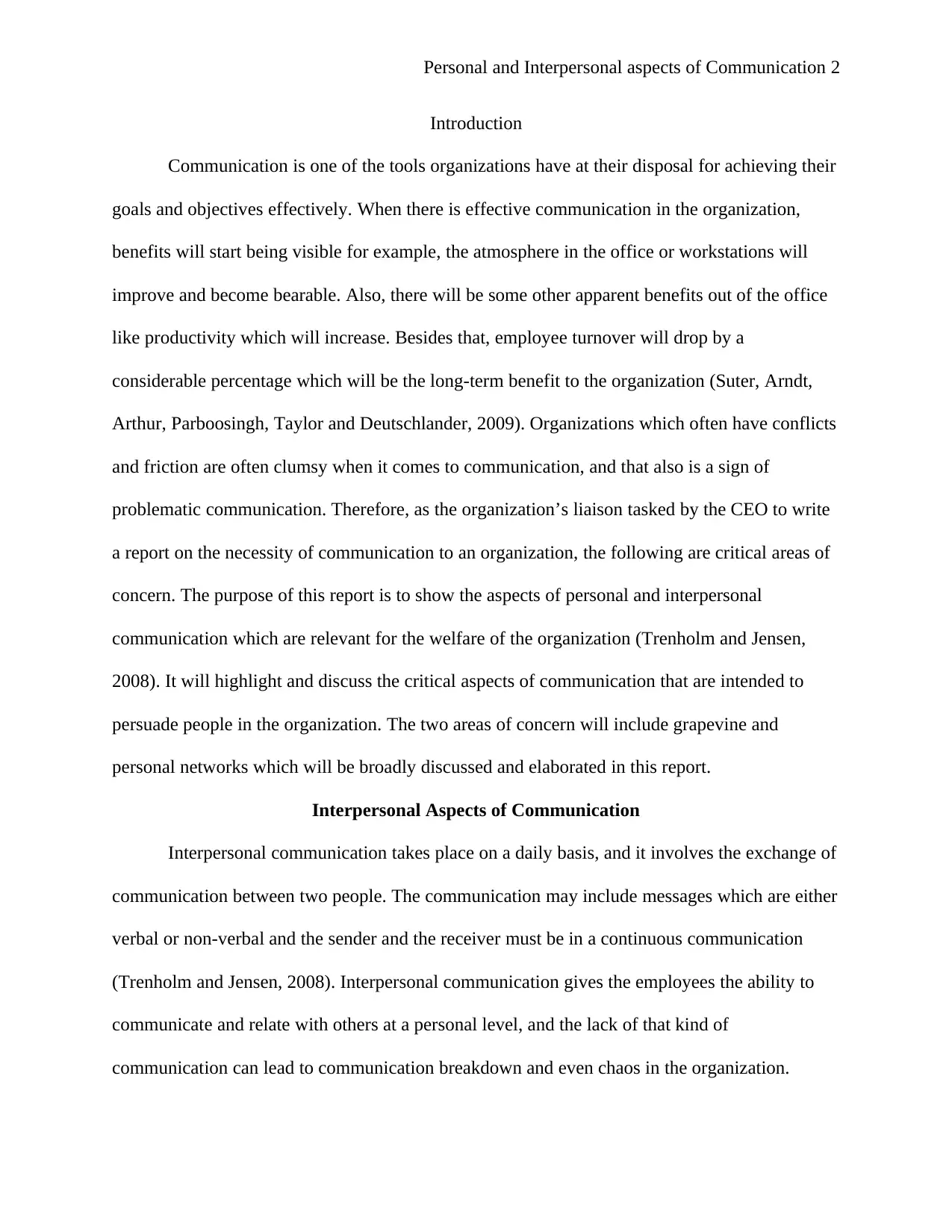
Personal and Interpersonal aspects of Communication 2
Introduction
Communication is one of the tools organizations have at their disposal for achieving their
goals and objectives effectively. When there is effective communication in the organization,
benefits will start being visible for example, the atmosphere in the office or workstations will
improve and become bearable. Also, there will be some other apparent benefits out of the office
like productivity which will increase. Besides that, employee turnover will drop by a
considerable percentage which will be the long-term benefit to the organization (Suter, Arndt,
Arthur, Parboosingh, Taylor and Deutschlander, 2009). Organizations which often have conflicts
and friction are often clumsy when it comes to communication, and that also is a sign of
problematic communication. Therefore, as the organization’s liaison tasked by the CEO to write
a report on the necessity of communication to an organization, the following are critical areas of
concern. The purpose of this report is to show the aspects of personal and interpersonal
communication which are relevant for the welfare of the organization (Trenholm and Jensen,
2008). It will highlight and discuss the critical aspects of communication that are intended to
persuade people in the organization. The two areas of concern will include grapevine and
personal networks which will be broadly discussed and elaborated in this report.
Interpersonal Aspects of Communication
Interpersonal communication takes place on a daily basis, and it involves the exchange of
communication between two people. The communication may include messages which are either
verbal or non-verbal and the sender and the receiver must be in a continuous communication
(Trenholm and Jensen, 2008). Interpersonal communication gives the employees the ability to
communicate and relate with others at a personal level, and the lack of that kind of
communication can lead to communication breakdown and even chaos in the organization.
Introduction
Communication is one of the tools organizations have at their disposal for achieving their
goals and objectives effectively. When there is effective communication in the organization,
benefits will start being visible for example, the atmosphere in the office or workstations will
improve and become bearable. Also, there will be some other apparent benefits out of the office
like productivity which will increase. Besides that, employee turnover will drop by a
considerable percentage which will be the long-term benefit to the organization (Suter, Arndt,
Arthur, Parboosingh, Taylor and Deutschlander, 2009). Organizations which often have conflicts
and friction are often clumsy when it comes to communication, and that also is a sign of
problematic communication. Therefore, as the organization’s liaison tasked by the CEO to write
a report on the necessity of communication to an organization, the following are critical areas of
concern. The purpose of this report is to show the aspects of personal and interpersonal
communication which are relevant for the welfare of the organization (Trenholm and Jensen,
2008). It will highlight and discuss the critical aspects of communication that are intended to
persuade people in the organization. The two areas of concern will include grapevine and
personal networks which will be broadly discussed and elaborated in this report.
Interpersonal Aspects of Communication
Interpersonal communication takes place on a daily basis, and it involves the exchange of
communication between two people. The communication may include messages which are either
verbal or non-verbal and the sender and the receiver must be in a continuous communication
(Trenholm and Jensen, 2008). Interpersonal communication gives the employees the ability to
communicate and relate with others at a personal level, and the lack of that kind of
communication can lead to communication breakdown and even chaos in the organization.
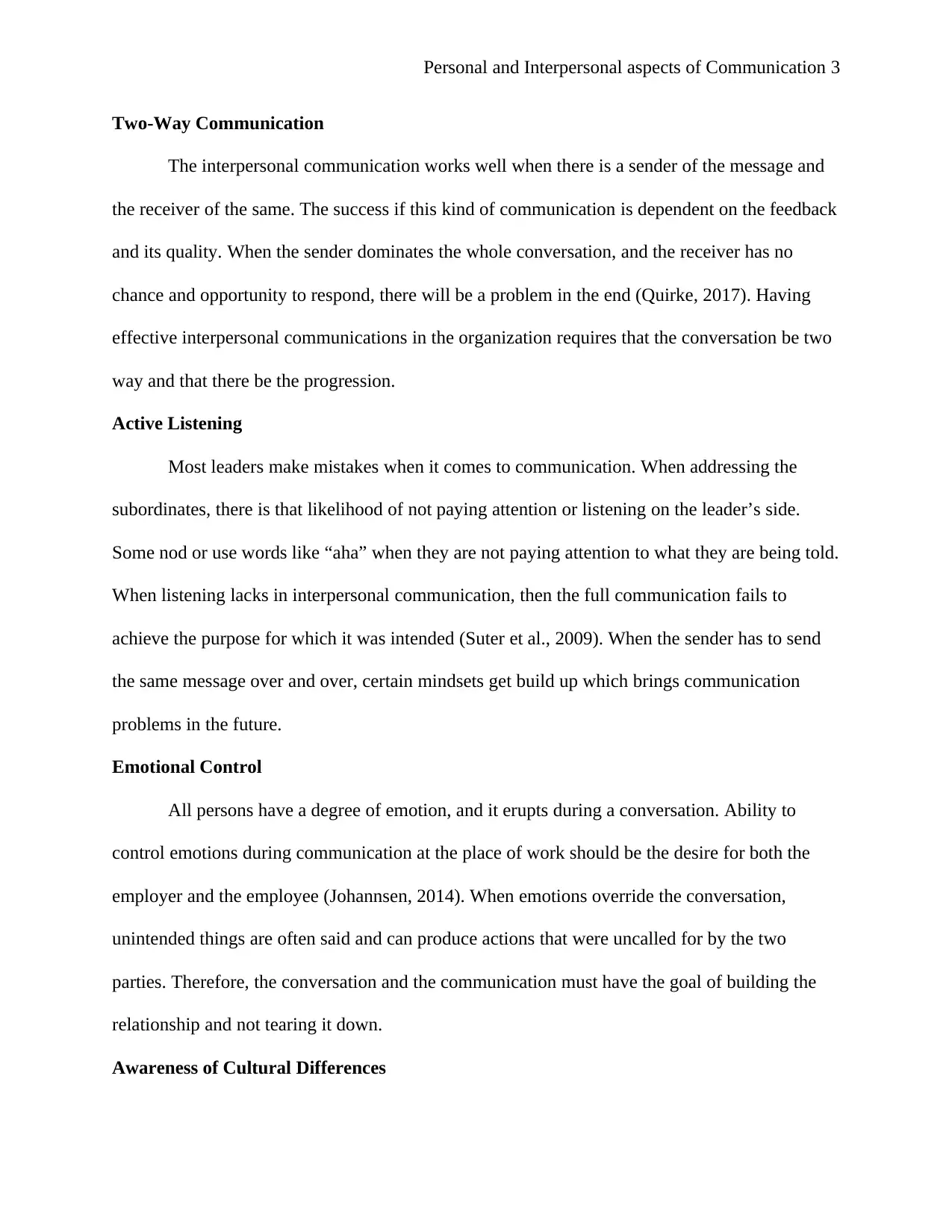
Personal and Interpersonal aspects of Communication 3
Two-Way Communication
The interpersonal communication works well when there is a sender of the message and
the receiver of the same. The success if this kind of communication is dependent on the feedback
and its quality. When the sender dominates the whole conversation, and the receiver has no
chance and opportunity to respond, there will be a problem in the end (Quirke, 2017). Having
effective interpersonal communications in the organization requires that the conversation be two
way and that there be the progression.
Active Listening
Most leaders make mistakes when it comes to communication. When addressing the
subordinates, there is that likelihood of not paying attention or listening on the leader’s side.
Some nod or use words like “aha” when they are not paying attention to what they are being told.
When listening lacks in interpersonal communication, then the full communication fails to
achieve the purpose for which it was intended (Suter et al., 2009). When the sender has to send
the same message over and over, certain mindsets get build up which brings communication
problems in the future.
Emotional Control
All persons have a degree of emotion, and it erupts during a conversation. Ability to
control emotions during communication at the place of work should be the desire for both the
employer and the employee (Johannsen, 2014). When emotions override the conversation,
unintended things are often said and can produce actions that were uncalled for by the two
parties. Therefore, the conversation and the communication must have the goal of building the
relationship and not tearing it down.
Awareness of Cultural Differences
Two-Way Communication
The interpersonal communication works well when there is a sender of the message and
the receiver of the same. The success if this kind of communication is dependent on the feedback
and its quality. When the sender dominates the whole conversation, and the receiver has no
chance and opportunity to respond, there will be a problem in the end (Quirke, 2017). Having
effective interpersonal communications in the organization requires that the conversation be two
way and that there be the progression.
Active Listening
Most leaders make mistakes when it comes to communication. When addressing the
subordinates, there is that likelihood of not paying attention or listening on the leader’s side.
Some nod or use words like “aha” when they are not paying attention to what they are being told.
When listening lacks in interpersonal communication, then the full communication fails to
achieve the purpose for which it was intended (Suter et al., 2009). When the sender has to send
the same message over and over, certain mindsets get build up which brings communication
problems in the future.
Emotional Control
All persons have a degree of emotion, and it erupts during a conversation. Ability to
control emotions during communication at the place of work should be the desire for both the
employer and the employee (Johannsen, 2014). When emotions override the conversation,
unintended things are often said and can produce actions that were uncalled for by the two
parties. Therefore, the conversation and the communication must have the goal of building the
relationship and not tearing it down.
Awareness of Cultural Differences
⊘ This is a preview!⊘
Do you want full access?
Subscribe today to unlock all pages.

Trusted by 1+ million students worldwide
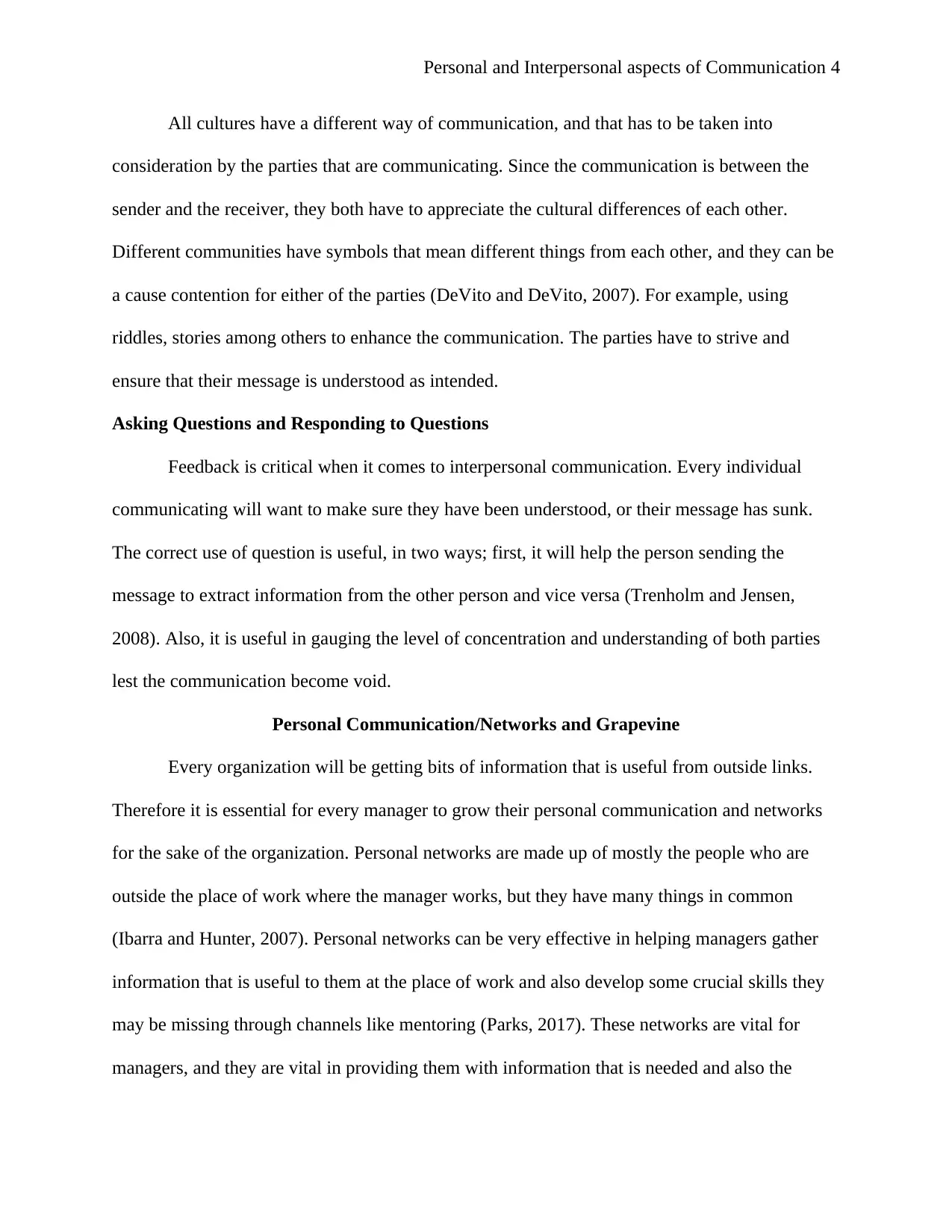
Personal and Interpersonal aspects of Communication 4
All cultures have a different way of communication, and that has to be taken into
consideration by the parties that are communicating. Since the communication is between the
sender and the receiver, they both have to appreciate the cultural differences of each other.
Different communities have symbols that mean different things from each other, and they can be
a cause contention for either of the parties (DeVito and DeVito, 2007). For example, using
riddles, stories among others to enhance the communication. The parties have to strive and
ensure that their message is understood as intended.
Asking Questions and Responding to Questions
Feedback is critical when it comes to interpersonal communication. Every individual
communicating will want to make sure they have been understood, or their message has sunk.
The correct use of question is useful, in two ways; first, it will help the person sending the
message to extract information from the other person and vice versa (Trenholm and Jensen,
2008). Also, it is useful in gauging the level of concentration and understanding of both parties
lest the communication become void.
Personal Communication/Networks and Grapevine
Every organization will be getting bits of information that is useful from outside links.
Therefore it is essential for every manager to grow their personal communication and networks
for the sake of the organization. Personal networks are made up of mostly the people who are
outside the place of work where the manager works, but they have many things in common
(Ibarra and Hunter, 2007). Personal networks can be very effective in helping managers gather
information that is useful to them at the place of work and also develop some crucial skills they
may be missing through channels like mentoring (Parks, 2017). These networks are vital for
managers, and they are vital in providing them with information that is needed and also the
All cultures have a different way of communication, and that has to be taken into
consideration by the parties that are communicating. Since the communication is between the
sender and the receiver, they both have to appreciate the cultural differences of each other.
Different communities have symbols that mean different things from each other, and they can be
a cause contention for either of the parties (DeVito and DeVito, 2007). For example, using
riddles, stories among others to enhance the communication. The parties have to strive and
ensure that their message is understood as intended.
Asking Questions and Responding to Questions
Feedback is critical when it comes to interpersonal communication. Every individual
communicating will want to make sure they have been understood, or their message has sunk.
The correct use of question is useful, in two ways; first, it will help the person sending the
message to extract information from the other person and vice versa (Trenholm and Jensen,
2008). Also, it is useful in gauging the level of concentration and understanding of both parties
lest the communication become void.
Personal Communication/Networks and Grapevine
Every organization will be getting bits of information that is useful from outside links.
Therefore it is essential for every manager to grow their personal communication and networks
for the sake of the organization. Personal networks are made up of mostly the people who are
outside the place of work where the manager works, but they have many things in common
(Ibarra and Hunter, 2007). Personal networks can be very effective in helping managers gather
information that is useful to them at the place of work and also develop some crucial skills they
may be missing through channels like mentoring (Parks, 2017). These networks are vital for
managers, and they are vital in providing them with information that is needed and also the
Paraphrase This Document
Need a fresh take? Get an instant paraphrase of this document with our AI Paraphraser
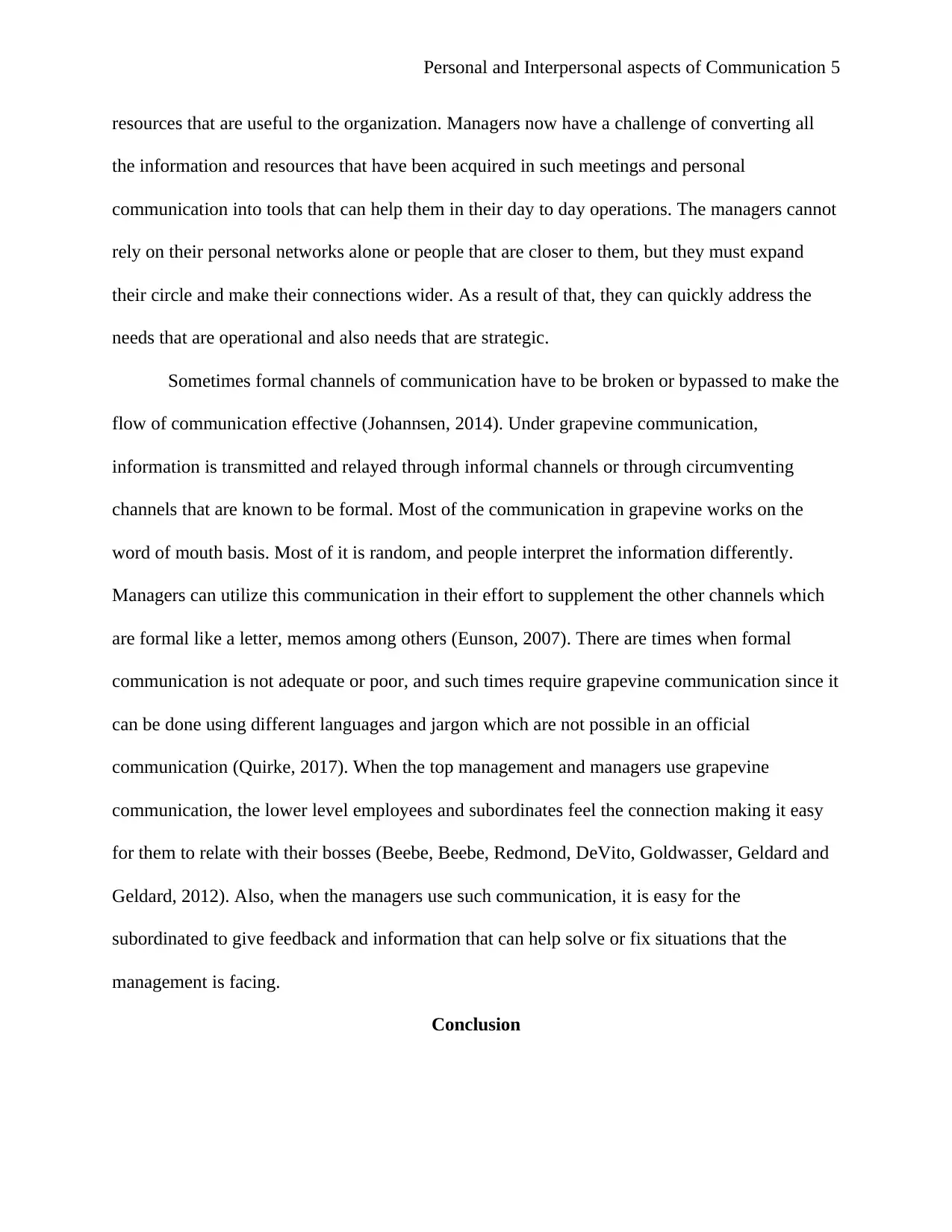
Personal and Interpersonal aspects of Communication 5
resources that are useful to the organization. Managers now have a challenge of converting all
the information and resources that have been acquired in such meetings and personal
communication into tools that can help them in their day to day operations. The managers cannot
rely on their personal networks alone or people that are closer to them, but they must expand
their circle and make their connections wider. As a result of that, they can quickly address the
needs that are operational and also needs that are strategic.
Sometimes formal channels of communication have to be broken or bypassed to make the
flow of communication effective (Johannsen, 2014). Under grapevine communication,
information is transmitted and relayed through informal channels or through circumventing
channels that are known to be formal. Most of the communication in grapevine works on the
word of mouth basis. Most of it is random, and people interpret the information differently.
Managers can utilize this communication in their effort to supplement the other channels which
are formal like a letter, memos among others (Eunson, 2007). There are times when formal
communication is not adequate or poor, and such times require grapevine communication since it
can be done using different languages and jargon which are not possible in an official
communication (Quirke, 2017). When the top management and managers use grapevine
communication, the lower level employees and subordinates feel the connection making it easy
for them to relate with their bosses (Beebe, Beebe, Redmond, DeVito, Goldwasser, Geldard and
Geldard, 2012). Also, when the managers use such communication, it is easy for the
subordinated to give feedback and information that can help solve or fix situations that the
management is facing.
Conclusion
resources that are useful to the organization. Managers now have a challenge of converting all
the information and resources that have been acquired in such meetings and personal
communication into tools that can help them in their day to day operations. The managers cannot
rely on their personal networks alone or people that are closer to them, but they must expand
their circle and make their connections wider. As a result of that, they can quickly address the
needs that are operational and also needs that are strategic.
Sometimes formal channels of communication have to be broken or bypassed to make the
flow of communication effective (Johannsen, 2014). Under grapevine communication,
information is transmitted and relayed through informal channels or through circumventing
channels that are known to be formal. Most of the communication in grapevine works on the
word of mouth basis. Most of it is random, and people interpret the information differently.
Managers can utilize this communication in their effort to supplement the other channels which
are formal like a letter, memos among others (Eunson, 2007). There are times when formal
communication is not adequate or poor, and such times require grapevine communication since it
can be done using different languages and jargon which are not possible in an official
communication (Quirke, 2017). When the top management and managers use grapevine
communication, the lower level employees and subordinates feel the connection making it easy
for them to relate with their bosses (Beebe, Beebe, Redmond, DeVito, Goldwasser, Geldard and
Geldard, 2012). Also, when the managers use such communication, it is easy for the
subordinated to give feedback and information that can help solve or fix situations that the
management is facing.
Conclusion
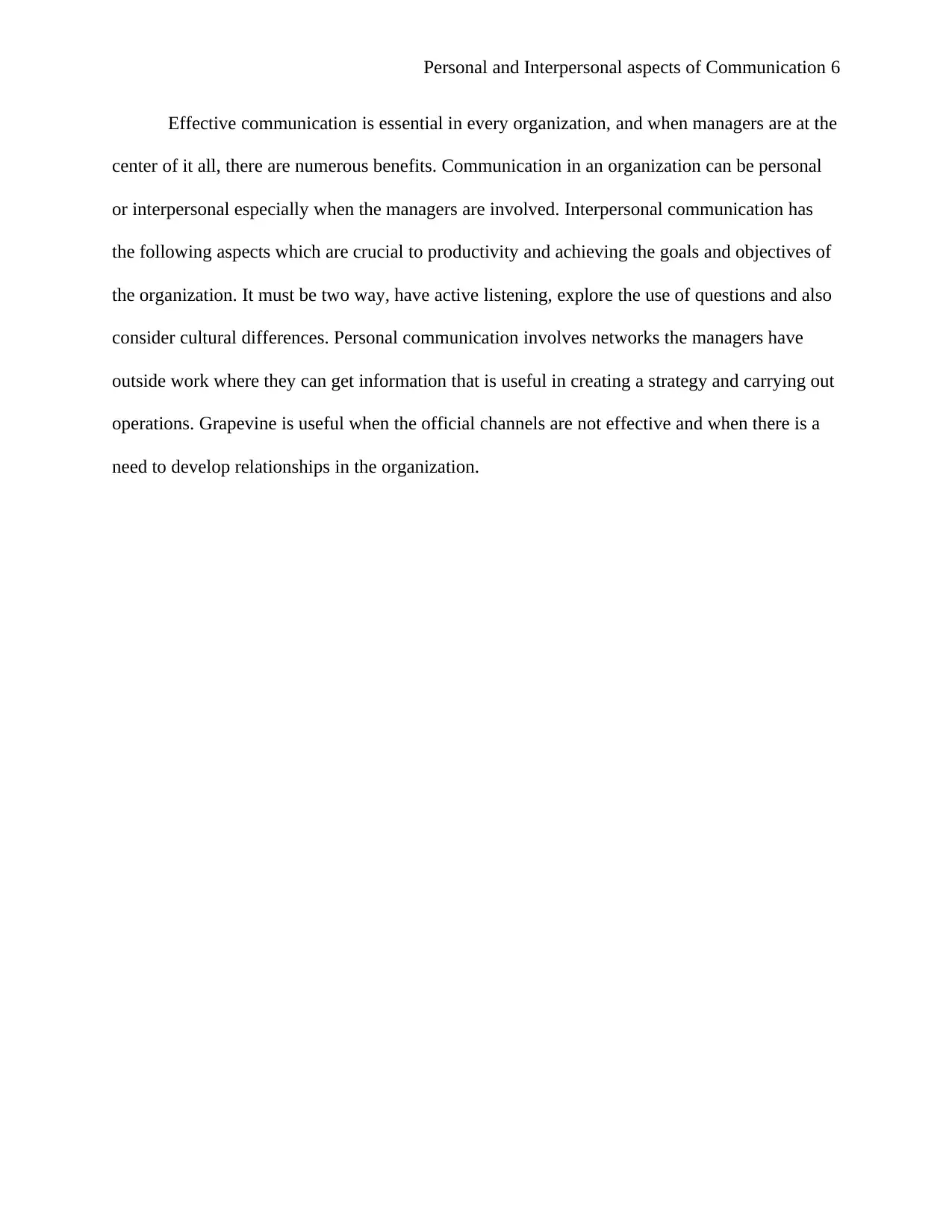
Personal and Interpersonal aspects of Communication 6
Effective communication is essential in every organization, and when managers are at the
center of it all, there are numerous benefits. Communication in an organization can be personal
or interpersonal especially when the managers are involved. Interpersonal communication has
the following aspects which are crucial to productivity and achieving the goals and objectives of
the organization. It must be two way, have active listening, explore the use of questions and also
consider cultural differences. Personal communication involves networks the managers have
outside work where they can get information that is useful in creating a strategy and carrying out
operations. Grapevine is useful when the official channels are not effective and when there is a
need to develop relationships in the organization.
Effective communication is essential in every organization, and when managers are at the
center of it all, there are numerous benefits. Communication in an organization can be personal
or interpersonal especially when the managers are involved. Interpersonal communication has
the following aspects which are crucial to productivity and achieving the goals and objectives of
the organization. It must be two way, have active listening, explore the use of questions and also
consider cultural differences. Personal communication involves networks the managers have
outside work where they can get information that is useful in creating a strategy and carrying out
operations. Grapevine is useful when the official channels are not effective and when there is a
need to develop relationships in the organization.
⊘ This is a preview!⊘
Do you want full access?
Subscribe today to unlock all pages.

Trusted by 1+ million students worldwide
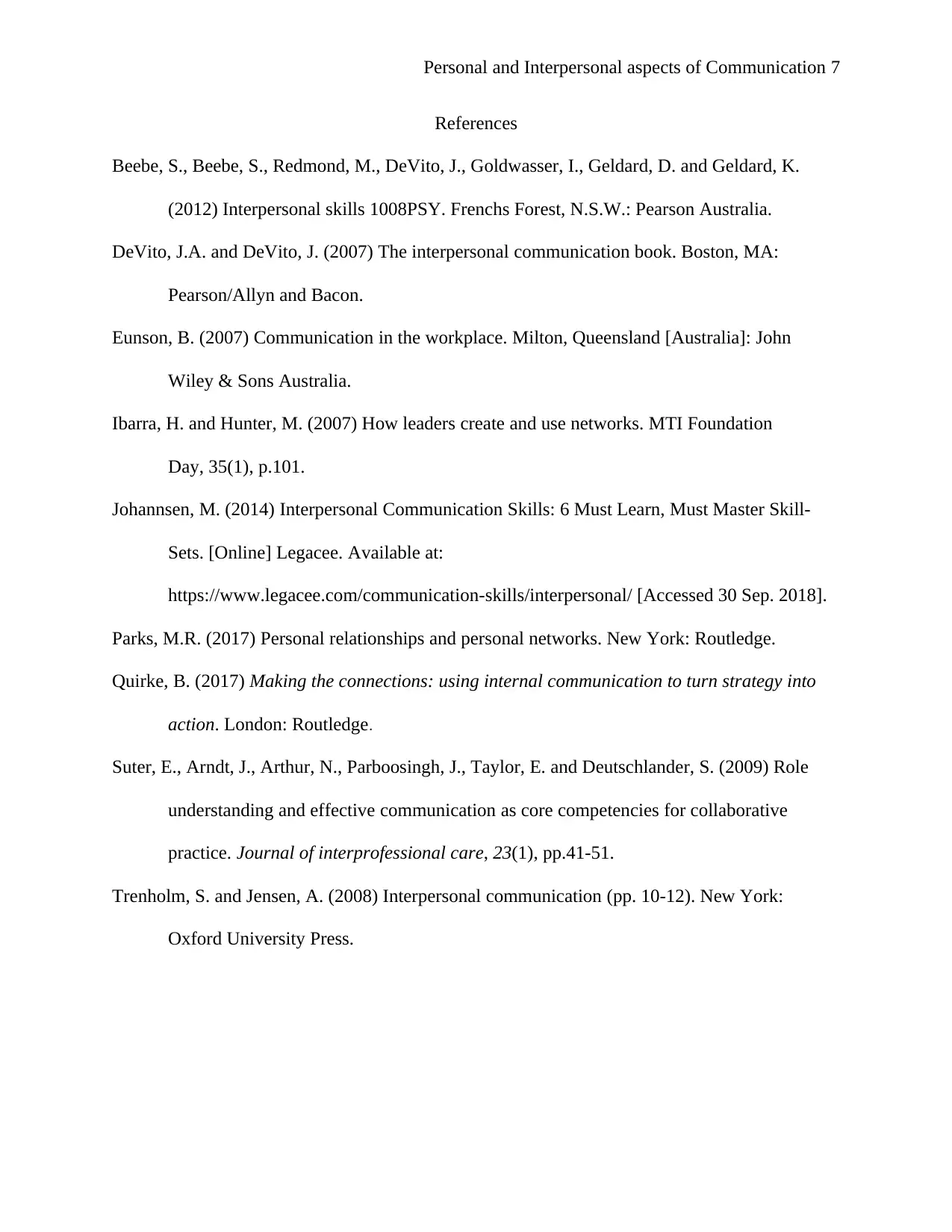
Personal and Interpersonal aspects of Communication 7
References
Beebe, S., Beebe, S., Redmond, M., DeVito, J., Goldwasser, I., Geldard, D. and Geldard, K.
(2012) Interpersonal skills 1008PSY. Frenchs Forest, N.S.W.: Pearson Australia.
DeVito, J.A. and DeVito, J. (2007) The interpersonal communication book. Boston, MA:
Pearson/Allyn and Bacon.
Eunson, B. (2007) Communication in the workplace. Milton, Queensland [Australia]: John
Wiley & Sons Australia.
Ibarra, H. and Hunter, M. (2007) How leaders create and use networks. MTI Foundation
Day, 35(1), p.101.
Johannsen, M. (2014) Interpersonal Communication Skills: 6 Must Learn, Must Master Skill-
Sets. [Online] Legacee. Available at:
https://www.legacee.com/communication-skills/interpersonal/ [Accessed 30 Sep. 2018].
Parks, M.R. (2017) Personal relationships and personal networks. New York: Routledge.
Quirke, B. (2017) Making the connections: using internal communication to turn strategy into
action. London: Routledge.
Suter, E., Arndt, J., Arthur, N., Parboosingh, J., Taylor, E. and Deutschlander, S. (2009) Role
understanding and effective communication as core competencies for collaborative
practice. Journal of interprofessional care, 23(1), pp.41-51.
Trenholm, S. and Jensen, A. (2008) Interpersonal communication (pp. 10-12). New York:
Oxford University Press.
References
Beebe, S., Beebe, S., Redmond, M., DeVito, J., Goldwasser, I., Geldard, D. and Geldard, K.
(2012) Interpersonal skills 1008PSY. Frenchs Forest, N.S.W.: Pearson Australia.
DeVito, J.A. and DeVito, J. (2007) The interpersonal communication book. Boston, MA:
Pearson/Allyn and Bacon.
Eunson, B. (2007) Communication in the workplace. Milton, Queensland [Australia]: John
Wiley & Sons Australia.
Ibarra, H. and Hunter, M. (2007) How leaders create and use networks. MTI Foundation
Day, 35(1), p.101.
Johannsen, M. (2014) Interpersonal Communication Skills: 6 Must Learn, Must Master Skill-
Sets. [Online] Legacee. Available at:
https://www.legacee.com/communication-skills/interpersonal/ [Accessed 30 Sep. 2018].
Parks, M.R. (2017) Personal relationships and personal networks. New York: Routledge.
Quirke, B. (2017) Making the connections: using internal communication to turn strategy into
action. London: Routledge.
Suter, E., Arndt, J., Arthur, N., Parboosingh, J., Taylor, E. and Deutschlander, S. (2009) Role
understanding and effective communication as core competencies for collaborative
practice. Journal of interprofessional care, 23(1), pp.41-51.
Trenholm, S. and Jensen, A. (2008) Interpersonal communication (pp. 10-12). New York:
Oxford University Press.
Paraphrase This Document
Need a fresh take? Get an instant paraphrase of this document with our AI Paraphraser

Personal and Interpersonal aspects of Communication 8
1 out of 8
Related Documents
Your All-in-One AI-Powered Toolkit for Academic Success.
+13062052269
info@desklib.com
Available 24*7 on WhatsApp / Email
![[object Object]](/_next/static/media/star-bottom.7253800d.svg)
Unlock your academic potential
Copyright © 2020–2025 A2Z Services. All Rights Reserved. Developed and managed by ZUCOL.




